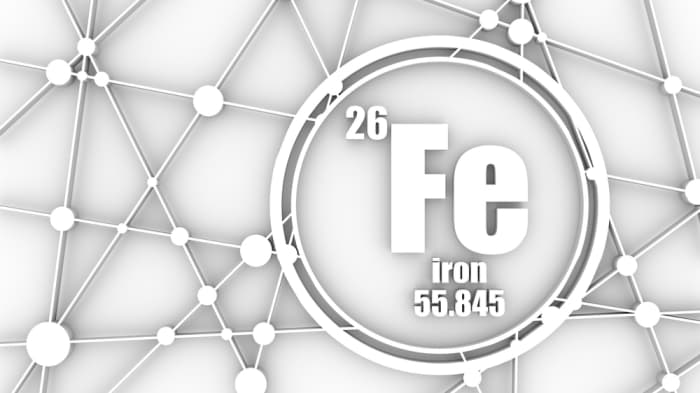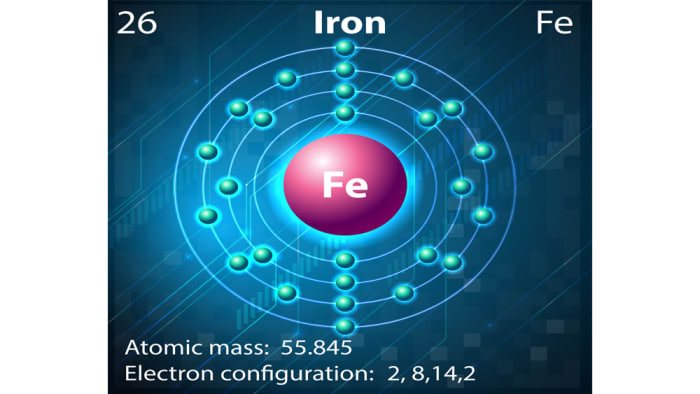Chemical reactions of iron with simple and complex substances, and its role in human activity
Properties of iron

Iron is the second most widespread metal on Earth. It has a medium chemical activity and is used by humans in a wide range of activities. It is metal with magnetic properties.
Distribution of iron in nature
Many minerals contain iron – for example magnetite is 72% iron. This mineral known as “magnetic iron ore” is dark gray (almost black) and has a characteristic metallic shine. Hematite is another mineral with a high iron content (up to 70%). This element is known as “red iron ore”, and is dark red with a brown tinge to grayish-red.
Limonite is a mineral with an iron content of 85%. This element is a crystal hydrate, which is yellow, or more rarely brown. Limonite is known as “brown iron ore” and used as a pigment.

Siderite is a mineral known as “spathic iron ore”, and has an iron content of 35%. The structure of the element is heterogenous and consists of crystals of gray, yellow and brown tinges.
Pyrite is a mineral with an iron content of 47%. This element has a yellow-golden tinge because of the sulfur atoms present in it.
Many of the minerals listed above are used for the production of pure iron. Iron is present in living organisms and is an important component of cells. For the proper functioning of the human body, a sufficient amount of this microelement must be consumed, which has a positive effect on the state of the blood.
Chemical properties of iron

Iron has properties typical for other metals (the exception is metals in the electrochemical row to the right of hydrogen). Iron enters into a reaction with substances of different classes, and interacts with oxygen, carbon, phosphorus, halogens (bromine, iodine, fluorine and chlorine), and also nitrogen. These are not all the reactions of iron – this metal reacts with many elements.
To obtain iron oxide, the metal is burned, and the products of this chemical reaction depend on the proportions of the elements participating. Accordingly, the properties of iron oxide differ. This reaction can only be carried out at a high temperature.
The reaction between iron and nitrogen is also possible with heating. Chemical reactions with iron and phosphorus form phosphide, and iron also interacts with sulfur, forming sulfide (this takes place as a result of a combination reaction). Any chain reaction with iron and other elements requires special conditions – usually high temperatures, more rarely catalysts are used.
The interaction between iron and halogens is often used in industry – the reaction of bromination, chlorination, fluorination and iodination. This reaction takes place from the attachment of bromine, chlorine, fluorine or iodine atoms to iron atoms, with the subsequent formation of bromide, chloride, fluoride and iodide. At high temperature, iron bonds with silicon.
The diverse chemical properties of iron have given rise to the wide application of the metal in industry, which it is hard to imagine without the existence of iron.
Click here to see amazing experiments with iron.
Interaction of iron with complex substances
It is worth discussing the interaction of iron with substances whose molecules consists of at least two elements. On the interaction of incandescent iron with water, an oxidizing reaction takes place, as a result of which a basic oxide forms. The results of interaction will depend on the proportions of components – if you take 4 moles of water and 3 moles of iron, you will get hydrogen (gas with a harsh smell) and iron cinder.
The reaction of iron with salts and acids is also carried out. Iron forces hydrogen out of compounds by a displacement reaction. You can observe it by adding acid to iron. For example, when you mix diluted sulfuric acid and iron in identical molar proportions, hydrogen and iron sulfate form in identical molar proportions.
Another example of the displacement reaction:
The interaction with salts demonstrates that iron has reducing properties. With the use of iron, the less active metal is forced out of a salt. Example: if you mix one mole of iron and one mole of copper sulfate, the result is pure copper and iron sulfate in equal molar proportions.
Iron and its importance for the human body
Iron performs important functions at cellular level; this element is the basis for hemoglobin, without which transportation of oxygen in the blood from the lungs to the brain neurons and to all the tissues in the body would be impossible. Iron influences blood formation, and without it the thyroid gland would not work properly. Iron regulates the immunity and takes part in intercellular metabolism, and many enzymes in the human body would not form without it. To avoid suffering from a deficit of iron, people should regular consume products containing this microelement.

How iron is produced for industry
Metal is mainly produced from minerals – hematite and magnetite. This is done by reducing iron from its compounds with carbon in the form of coke. The process takes place in blast furnaces at a temperature of 2,000 °C. The method of reducing iron by hydrogen is also used – special clay is required, which is mixed with crushed ore and processed with hydrogen from a shaft furnace.
Iron is widespread across the entire planet and comprises up to 5% of the earth’s crust. It is believed that the majority of the earth’s core consists of iron.